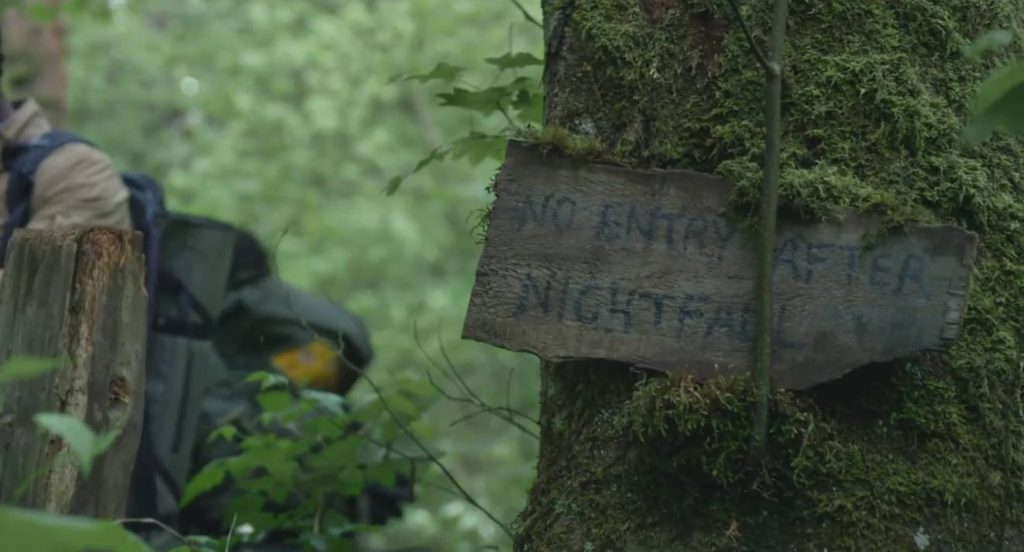
When I slept too late to get to my local theatre’s 10 AM opening day showing of Blair Witch, I began to dread the 12:30 PM showing I’d inevitably wind up at instead, because, by my gut calculations, it would have at least double the crowd. Some people live for a packed house at horror films, but that’s never been my bag; how am I supposed to be scared while surrounded by crinkling candy containers, squeaking seats, and that one guy who has a tuberculosis-inflected coughing fit inexplicably just as the tension peaks onscreen? Still, as a found-footage devotee (and gleeful volunteer for film reviewing duties), I knew I had to brave the wilderness that is other people to see what I’d make of a piece I was dreading by a director I adore. So, I arrived my customary fifteen minutes early and plunked down right in the center of an empty theater, bracing myself for the numbers in there to swell. Ten minutes to showtime, I’m still alone. Same thing five minutes to. The lights go down and I look around me to see if maybe I’d missed someone else, but no—I was going to get to experience Blair Witch alone, a serendipitous personal viewing experience for the small price of seven dollars. As the film began, I was positively ecstatic at my luck (and the movie’s apparent lack of crowd-drawing power), but by the end, I wished there were at least a few other souls in there with me to give Adam Wingard some money, because, and let me say this unequivocally, Blair Witch improves upon its seminal (though positively terrible) predecessor in literally every imaginable way.
It’s no big surprise to recurrent readers that I’m no fan of The Blair Witch Project, though it might be helpful to reiterate here why, if only to throw into stark relief how much Blair Witch improves upon it. Part of my reasons are outside the film’s control- as an avid fan of found footage, The Blair Witch Project‘s place as a groundbreaking touchstone has never sat well. Plenty of other films did the same conceit better before (Man Bites Dog is smarter, Alien Abduction: Incident In Lake County is scarier, The Last Broadcast was more formally ambitious, and Cannibal Holocaust was… well, more Cannibal Holocaust-y), and even more have improved upon it since (Lake Mungo, Lunopolis, Grave Encounters, [•REC], Europa Report, The Visit, August Underground, Bigfoot: The Lost Coast Tapes, the list goes on and on). All it had to its name was an astonishingly huge profit off a minuscule budget and massive box office, and it became shorthand for a sub-genre that is so much better than its most famous entries imply. Growing up as a punk kid (I even had a pink mohawk in high school, shaved sides and all), the easiest parallel I can draw is Green Day or Sex Pistols; their mediocrity in comparison to the truly great stuff no one seemed to care about made their fame almost feel like a personal insult. Of course, that is silly, and I’ll readily admit that, but it’s a knee-jerk reaction that’s tough to outgrow, especially as someone having to constantly defend the maligned sub-genre from undeserved and uninformed critical drubbings.
The second reason, however, is far more relatable: it simply isn’t very good. For a large portion of the film, nothing happens, and nothing happens at great length, though this isn’t precisely the problem: the problem is that this nothing is dreadfully boring to sit through. A nothing that characterizes or builds tension would be one thing, but out of nowhere character swings like throwing a much-needed map in the river and poorly shot tedium of haphazardly constructed stone signifiers amount to so little that you could swap around random scenes from most of the movie where nothing scary is directly happening and not substantially change the mood, tension, or progression of the rest of it. People remember the runs through the woods and the creepy house, but they forget that to get to those places they had to slog through some of the worst bad improv ever given a nationwide release. Maybe, maybe if the payoff was worth it, this could be forgiven, but the film’s suggestions never develop into a serious ominous or threatening atmosphere. The film is so massively vague about everything that while re-watching it at home, I couldn’t help but respond to Heather’s scream of, “What the fuck was that?” with an exasperated, “I don’t goddamn know!” There’s no concrete danger implied, instead amorphous suggestions that aren’t mysterious so much as they are immensely frustrating; I have nothing wrong with an existential or ambiguous source of fear in a horror film, but that unknowable nature has to be set up as part of the situation’s horror. Instead, The Blair Witch Project presents a supernatural but still knowable danger, but never gives us a reason to actually feel scared of it. It’s not the worst found footage movie I’ve ever seen (there’s some stinkers so miserable that even my clear hatred for The Blair Witch Project would seem jovial by comparison), it’s just that there’s nothing there to see.
So, saying Wingard improves upon this mess is hardly surprising, and for its first two acts, Blair Witch offers few surprises in general, though that’s not something I’m begrudging. Sure, it’s not You’re Next or The Guest, but expecting the kind of deadpan humor and shocking horror so masterfully played with there to be replicated in the third Blair Witch film (yes, there was a second one, the unfairly maligned and mostly forgotten Book of Shadows, though that’s a story for another day) was perhaps setting sights too high. But, as a genre that usually soars in indies (Mr. Jones as a recent example) and bombs in studio pictures (The Gallows and Area 51 being two of the particularly noxious releases of 2015), seeing well-delivered found footage getting a wide release is refreshing even without bells and whistles. Our main characters are all given humanizing moments that make them more relatable and empathetic than the grating, boorish assholes of the original, and it makes their stress and unraveling in the situation feel more earned, more understandable, and more frightening. We get a sense of why they’re out in the woods in the first place (all for different reasons, all understandable), and if their dialogue is much more clearly scripted, I’m all for it. I’ll take interesting, functional, and cleanly delivered scripting over the aimless first year improv classes of The Blair Witch Project any day of the week. Neither have verisimilitude, but at least one is actually entertaining.
But its in the third act that Blair Witch finds its purpose, and its purpose is that legendary house. Once inside, the wide-reaching and suggestive horror of the outside becomes laser-focused and as sharp as a knife, giving a final twenty minutes as forceful as any horror piece in recent memory. It’s concentrated, specific, and has the kind of inertia that just won’t let up, and it’s no coincidence that, once in the iconic location, Wingard’s ability to reference without being cutesy or overbearing comes into its strongest hold of the film, weaving together time and space relations in ways intuitively and intellectually interesting and wrought with both terror and meaning. Here, also, the movie finds the strongest argument for its found footage style, both enhancing the subjective nature of each character’s white-knuckle fight for their life and providing visual cues for how the parts are moving in the machine. The myriad cameras employed throughout—everything from grainy DV reminiscent of the original to epic vistas viewed via drone—become in the house both aesthetic and narrative tools. If this film has a personal stamp from its director, it’s this section’s completely controlled chaos, anxiety-inducing and constantly shifting but never imprecise or sloppy. It’s a masterful twenty or so minutes.
If the rest of the film were that distinctive and direct, it would probably be a modern classic. Instead, it’s a wholly satisfying and worthwhile effort from a director that deserves more than he was given to work with here. Such is Hollywood, I suppose, though I’ll take what I can get—a good, easily available horror experience on the big screen is something worth celebrating, even if my highest hopes and my darkest fears both ended up feeling just a bit let down. If there were any justice in the world, Blair Witch would break the box-office and overshadow its conspicuously boring forebear and become the one everyone remembers, or at the very least we get a sequel—I mean, every film in the series has improved upon the last, so why not try and go up again? But of course, this being the real world, it’s been a swing and a miss so far (as indicated by my deserted showing and the disappointing returns). The original will still be seen as perhaps the definitive found-footage film, much to the chagrin of any fan of the sub-genre, and the people who actually saw Blair Witch will be left trying to convince a bunch of uninterested parties that this one really is the better of the two. Keep an eye on it though—like other previously dismissed horror sequels (The Exorcist II comes to mind), I have a feeling this one’s got legs. Incredibly long, distressingly thin, horrifyingly nimble legs.
—
Directed by Adam Wingard; written by Simon Barrett; starring James Allen McCune, Callie Hernandez, Corbin Reid, and Brandon Scott; 89 minutes.



 Derek
Derek
 Isabelle
Isabelle